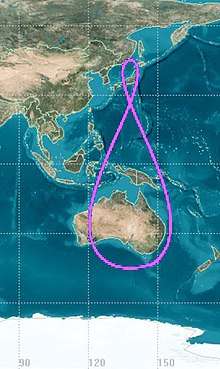Tundra orbit

A tundra orbit (Russian: Тундра) is a highly elliptical geosynchronous orbit with a high inclination (usually near 63.4°) and an orbital period of one sidereal day. A satellite placed in this orbit spends most of its time over a chosen area of the Earth, a phenomenon known as apogee dwell. The ground track of a satellite in a Tundra orbit is a closed figure-eight with a smaller loop over either the northern or southern hemisphere. Tundra orbits have moderate eccentricity, typically between 0.2 and 0.3. These orbits are conceptually similar to Molniya orbits, which have the same inclination but half the period.[1][2][3]
Until 2016, Sirius Satellite Radio, now part of Sirius XM Holdings, operated a constellation of three satellites in Tundra orbits for satellite radio.[4] The RAAN and mean anomaly of each satellite were offset by 120° so that when one satellite moved out of position, another had passed perigee and was ready to take over. The three satellites were launched in 2000 and moved into circular disposal orbits in 2016; Sirius XM now broadcasts only from geostationary satellites.[5][6][7]
Two spacecraft in Tundra orbits are able to provide continuous coverage over an area.[1][2]
Tundra and Molniya orbits are used to provide high-latitude users with higher elevation angles than a geostationary orbit. These orbits remain over their desired high-latitude regions for long periods of time due to their slow movement at apogee.[1] Neither the Tundra nor Molniya orbit is geostationary because that is possible only over the equator, so both orbits are elliptical to reduce the time that the satellite is away from its service area. An argument of perigee of 270° places apogee at the northernmost point of the orbit. An argument of perigee of 90° would likewise serve the high southern latitudes. An argument of perigee of 0° or 180° would cause the satellite to dwell over the equator, but there would be little point to this as this could be better done with a conventional geostationary orbit.
The Tundra and Molniya orbits use a sin−1 √4/5 ≈ 63.4° inclination to null the secular perturbation of the argument of perigee caused by the Earth's equatorial bulge. With any inclination other than 63.4° or its supplement, 116.6°, the argument of perigee would change steadily over time, and apogee would occur either before or after the highest latitude is reached.[1]
See also
References
- 1 2 3 4 Fortescue, P.W.; Mottershead, L.J.; Swinerd, G.; Stark, J.P.W. (2003). "Section 5.7: highly elliptic orbits". Spacecraft Systems Engineering. John Wiley and Sons. ISBN 0-471-61951-5.
- 1 2 Jenkin, A.B.; McVey, J.P.; Wilson, J.R.; Sorge, M.E. (2017). Tundra Disposal Orbit Study. 7th European Conference on Space Debris. ESA Space Debris Office.
- ↑ Mortari, D.; Wilkins, M.P.; Bruccoleri, C. (2004). "The Flower Constellations" (PDF): 4.
- ↑ "Sirius Rising: Proton-M Ready to Launch Digital Radio Satellite Into Orbit". AmericaSpace. Retrieved 8 July 2017.
- ↑ "Application for Modification". Federal Communications Commission.
- ↑ "Sirius XM Holdings 10-K 2015 Annual Report" (PDF).
- ↑ "Sirius XM Holdings 10-K 2016 Annual Report".